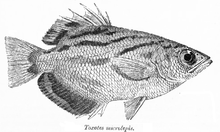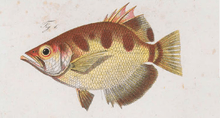Smallscale archerfish
| Toxotes microlepis | |
|---|---|
 | |
| Scientific classification | |
| Kingdom: | Animalia |
| Phylum: | Chordata |
| Class: | Actinopterygii |
| Order: | Perciformes |
| Family: | Toxotidae |
| Genus: | Toxotes |
| Species: | T. microlepis |
| Binomial name | |
| Toxotes microlepis (Günther, 1860) | |
The smallscale archerfish (Toxotes microlepis) is a perciform fish of genus Toxotes. As its name suggests, the scales of the smallscale archerfish are smaller than those of other archerfish.[2] They reach a maximum length of 15 centimetres (5.9 in).[3] Smallscale archerfish live in the tropical Indo-Pacific region and are potamodromous, moving between fresh and brackish water through their lifetimes.[3]
Description

Smallscale archerfish have a pointed snout and large eyes. The back is flat and the belly is curved. There is only one dorsal fin, with four to five dorsal spines.[3] The fourth spine is longer than the third. The second dorsal spine is slightly shorter than the third anal spine, which itself is shorter than the soft rays.[4] There are usually 40 to 42 lateral line scales, though some specimens found in the Mekong had 34 to 37.[5] The species T. blythii was formerly thought to be identical to T. microlepis. Differences in structure and colouration caused the splitting of T. blythii into a new species.[4]
Like other archerfish, they have dark, wedge-shaped bands or spots on its flanks,[4] which can be yellow to silvery.[3] They reach a maximum length of 15 centimetres (5.9 in) in the wild, and 12 centimetres (4.7 in) in captivity.[2] The smallscale archerfish is sometimes confused with the banded archerfish, T. jaculatrix.[2] Both species have four or five wedge-shaped bars on their flanks. However, the bars of banded archerfish extend to the dorsal fin whilst those of the smallscale archerfish do not; they stop below the dorsal fin, with another dark spot on the fin itself.[2] The smallscale is also has a shorter snout than other archerfish.[6]
Diet
Smallscale archerfish eat terrestrial insects (which they can shoot down), zooplankton, crustaceans, and insect larvae.[3][5]
Distribution and habitat
Smallscale archerfish inhabit large rivers and estuaries in Asia and the Indo-Pacific. They are distributed throughout the Mekong and Chao Phraya river basins as well as waters off the Malay Peninsula, Sumatra and Borneo.[3] They can be found near the shores of moving and standing waters, usually with overhanging plants. The smallscale archerfish is described as a "freshwater archerfish", as it does not move into saltwater during its life as do some other archerfish.[2] It is found upstream from the estuary more often than other species of the genus.[5]
Relationship to humans
Some aquarists believe the smallscale archerfish is the most frequently traded archerfish.[2] It is often confused with other archerfish (such as the banded archerfish and largescale archerfish), and may be sold with the others as one species. Smallscale archerfish do not need brackish water as do other members of its genus (though it can also live in brackish water);[7] it is thus sometimes sold as the "freshwater archerfish".[2]
References
- ↑ Allen, D. (2011). "Toxotes microlepis". IUCN Red List of Threatened Species. Version 2012.1. International Union for Conservation of Nature. Retrieved 25 October 2012.
- 1 2 3 4 5 6 7 Monks, Neale; Bruce Hansen. "Archerfish, family Toxotidae". Brackish Water Aquarium FAQ. Retrieved 1 March 2010.
- 1 2 3 4 5 6 Froese, Rainer and Pauly, Daniel, eds. (2010). "Toxotes microlepis" in FishBase. January 2010 version.
- 1 2 3 Günther, Albert C. L.G.; William Carruthers; William Francis (1892). The Annals and magazine of natural history: zoology, botany, and geology. Sixth. IX. London: Taylor and Francis. pp. 143–144.
- 1 2 3 Rainboth, Walter J. (1996). Fishes of the Cambodian Mekong. Food & Agriculture Org. p. 190. ISBN 92-5-103743-4.
- ↑ Günther, Albert C. L. G. (1860). Catalogue of the Fishes in the British Museum. British Museum of Natural History. pp. 68–69.
- ↑ Monks, Neale. "The Wonder of Wildwoods" (PDF). Wildwoods Water Gardens. Retrieved 4 March 2010.
- "Toxotes microlepis". Integrated Taxonomic Information System. Retrieved 3 March 2010.
